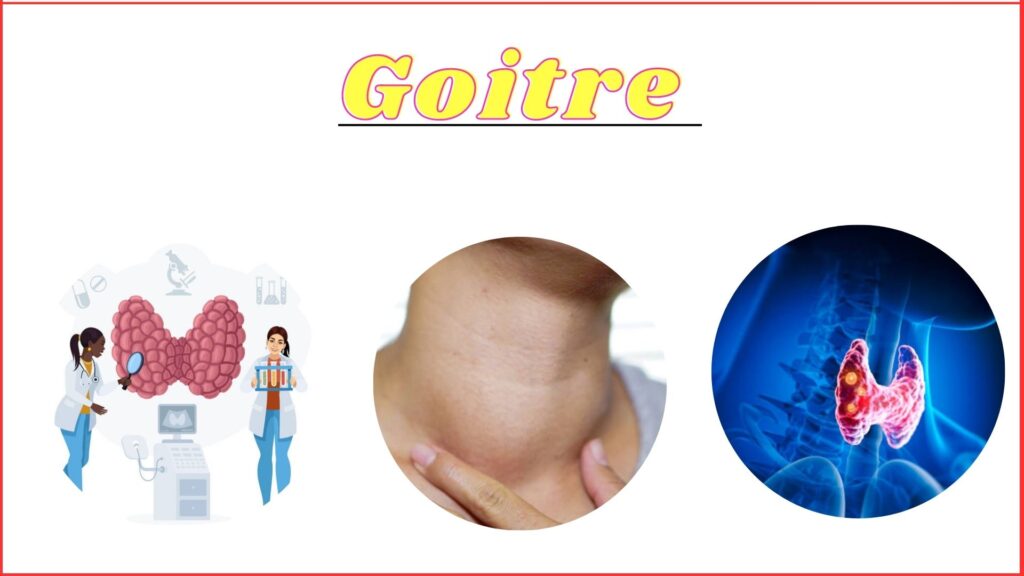Goitre : definition, Symptoms, treatment & thyroid
Goitre
We have described in article :
Definition of goitre
Classification of goitre.
Definition of simple goitre
Causes of simple goitre
Stages of multinodular goitre
Treatment of simple goitre
Management of simple goitre

Definition of goitre :
Goitre : The normal thyroid gland is impalpable. The term goitre (from Latin guttur = the throat) is used to describe generalized enlargement of the thyroid gland.
- A discrete swelling (nodule) in one lobe with no palpable abnormality elsewhere is termed as isolated (or solitary) swelling.
- Discrete swelling with evidence of abnormality elsewhere in the gland is termed dominant.
Classification of goitre / thyroid swelling :
Simple goitre :
- Diffuse hyperplastic goitre
- Physiological
- Pubertal
- Pregnancy
- Multinodular goite
Toxic goitre :
- Diffuse toxic goitre (Grave’s disease)
- Multinodular goitre
- Toxic adenoma
Neoplastic goitre :
- Benign
- Malignant
Inflammatory goitre :
Autoimmune :
- Chronic lymphocytic thyroiditis
- Hashimoto’s thyroiditis
Granulomatous :
- De Quervain’s thyroiditis
Fibrosing :
- Riedel’s thyroiditis
Infective :
- Acute (Bacterial thyroiditis, viral thyroiditis, sub-acute thyroiditis)
- Chronic (tuberculous, syphilitic)
Other :
- Amyloid
Define simple goitre :
Simple goitre : Simple goitre may develop as a result of stimulation of the thyroid gland by TSH, either as a result of inappropriate secretion from a microadenoma in the anterior pituitary (which is rare), or in response a chronically low level of circulating thyroid hormones.
Causes of simple goitre :
- lodine deficiency (Endemic)
- Enzyme deficiency (Sporadic).
- Presence of goitrogens in diet.
Stages of multinodular goitre :
Stages in goitre formation are:
Persistent TSH stimulation – Diffuse hyperplasia of gland (all active lobules) – Later with fluctuation of TSH level – Mixed areas of active and inactive lobules develop. It is also probably due to increased sensitivity of follicular cells to TSH – Haemorrhages occur with necrosis in the – Nodule formation – Centre of the nodule is inactive and only margin is active, i.e. internodular tissue is active – Formation of many nodules – Multinodular goitre (MNG)
Other factors involved are growth stimulating immunoglobulins and growth prone cell clones.
Complications of long standing multinodular goitre :
- Secondary thyrotoxicosis (30%).
- Follicular carcinoma of thyroid.
- Haemorrhage.
- Tracheal compression.
- Tracheal obstruction.
- Tracheal calcification.
- Cosmetic problem.
Management of simple goitre :
Diagnosis of simple goitre :
- Straightforward diagnosis
- Patient is euthyroid.
- The nodules are palpable and often visible.
- Nodules are smooth, usually firm and not hard.
- The goitre is painless and moves freely on swallowing
- Hardness and irregularity, due to calcification, may simulate carcinoma.
- A painful nodule, sudden appearance, or rapid enlargement of a nodule raises spicion of carcinoma but is usually due to haemorrhage into a simple nodule.
Investigations of simple goitre :
- Thyroid function test: T,, T, & TSH.
- Ultrasound is the gold standard.
- FNAC (ultrasound guided is ideal).
- Ultrasound guided biopsy.
- CT scan of the thoracle inlet. If there is swallowing or breathing symptoms.
Treatment simple goitre :
- In endemic areas : The incidence of goitre has been strikingly reduced by the introduction of iodized salt.
- In the early stages : Hyperplastic goitre may regress if thymine is given in a dose of 0.15-03 mg daily for a few months.
- Although the nodular stage of simple goitre is imeversible, more than half of benign nodules will regress in size over ten years.
- Most patients with multinodular goitre are asymptomatic and do not require operation.
Surgery :
Consideration of surgery :
- Cosmetic purpose
- Patient wish
- Pressure symptons
- Carcinomatous changes.
Options :
- Total thyroidectomy
- Subtotal thyroidectomy

Greetings! Very helpful advice in this particular article! Its the little changes that produce the largest changes. Thanks a lot for sharing!
This design is incredible! You obviously know how to keep a reader amused. Between your wit and your videos, I was almost moved to start my own blog (well, almost…HaHa!) Excellent job. I really loved what you had to say, and more than that, how you presented it. Too cool!